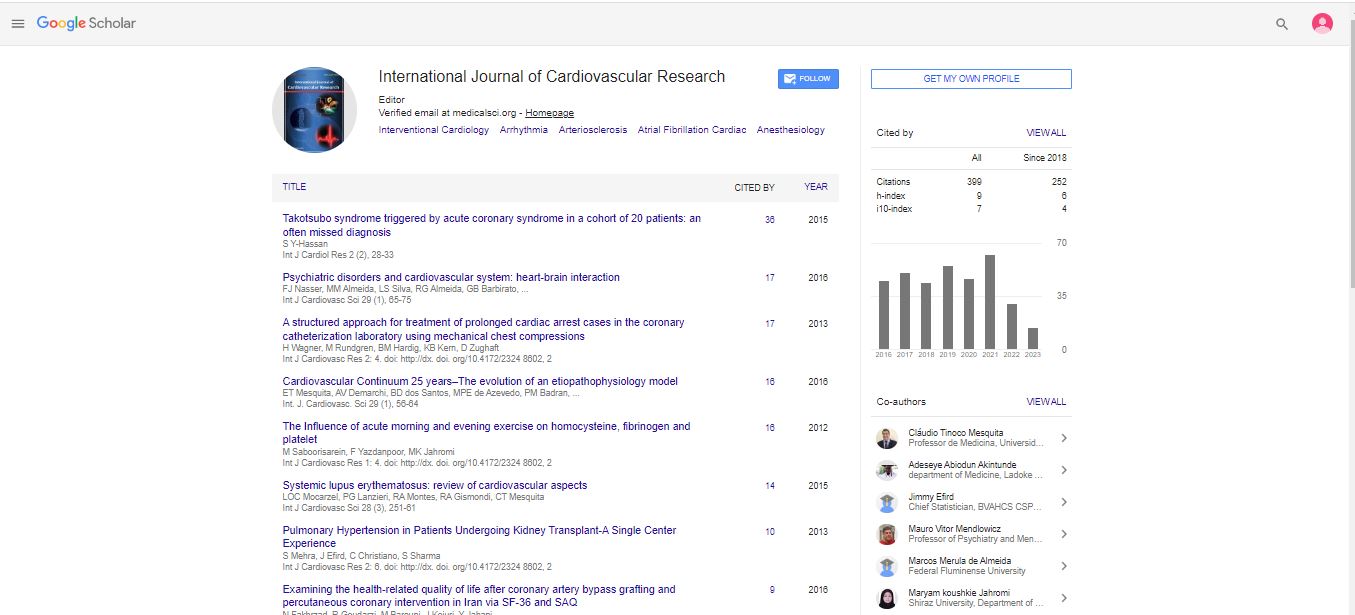Research Article, Int J Cardiovasc Res Vol: 5 Issue: 1
Modulation of miRNAs in Aneurysms of the Ascending Aorta: Local versus Circulating Expression Levels
| Manfred Richter1,2, Ali El-Sayed Ahmed1, Spiros Marinos1, Andreas Zierer1, Anton Moritz1, Andres Beiras-Fernandez1 and Isabella Werner1* | |
| 1Department of Thoracic and Cardiovascular Surgery, University Hospital Frankfurt, Goethe University, Frankfurt/Main, Germany | |
| 2Department of Cardiac Surgery, Kerckhoff Heart and Thoracic Center, Bad Nauheim, Germany | |
| Corresponding author : Isabella Werner Department of Thoracic and Cardiovascular Surgery, University Hospital Frankfurt, Goethe University, Theodor Stern Kai 7, 60590 Frankfurt am Main / Germany, Tel: 0049 69 6301-6500 Fax: 0049 69 6301-7108 E-mail: Isabella.Werner@kgu.de |
|
| Received: October 09, 2015 Accepted: November 23, 2015 Published: November 30, 2015 | |
| Citation: Richter M, El-Sayed Ahmed A, Marinos S, Zierer A, Moritz A, et al. (2015) Modulation of miRNAs in Aneurysms of the Ascending Aorta: Local versus Circulating Expression Levels. Int J Cardiovasc Res 5:1. doi:10.4172/2324-8602.1000248 |
Abstract
Modulation of miRNAs in Aneurysms of the Ascending Aorta: Local versus Circulating Expression Levels
Objective: The identification and treatment of ascending aortic aneurysms (AAA) is still challenging, as the detailed mechanisms leading to AAA formation, progression and rupture, are insufficiently understood. Different miRNAs are known to play important roles in vascular degeneration and the formation of aneurysms in Marfan patients. Thus we investigated the expression profile of miRNAs in patients with AcsAA.
Methods: Ascending aortic tissue samples of patients with aneurysms undergoing aortic surgery were compared with ascending aortic tissue samples of patients without dilatation. We analyzed the expression of different miRNAs by RT-PCR in tissue and serum samples of the same patients´ collective.
Results: We observed a significant down-regulation in tissue expression of miRNA-21, miRNA-151, miRNA-152, miRNA-155 and miRNA-182 in the AAA group compared to controls. MiRNA-152 was also significantly reduced in the serum of patients with aneurysm of the ascending aorta.
Conclusions: The significant down-regulation of miRNA-21, -151, -152 and -155 in the AAA group compared to the control offers new therapeutic starting points to limit aneurysm progression by preventing its expansion and reducing the atherosclerotic damage, respectively. By analyzing and comparing tissue expression with the serum-levels we might find biomarkers with prognostic value in high-risk patients.




